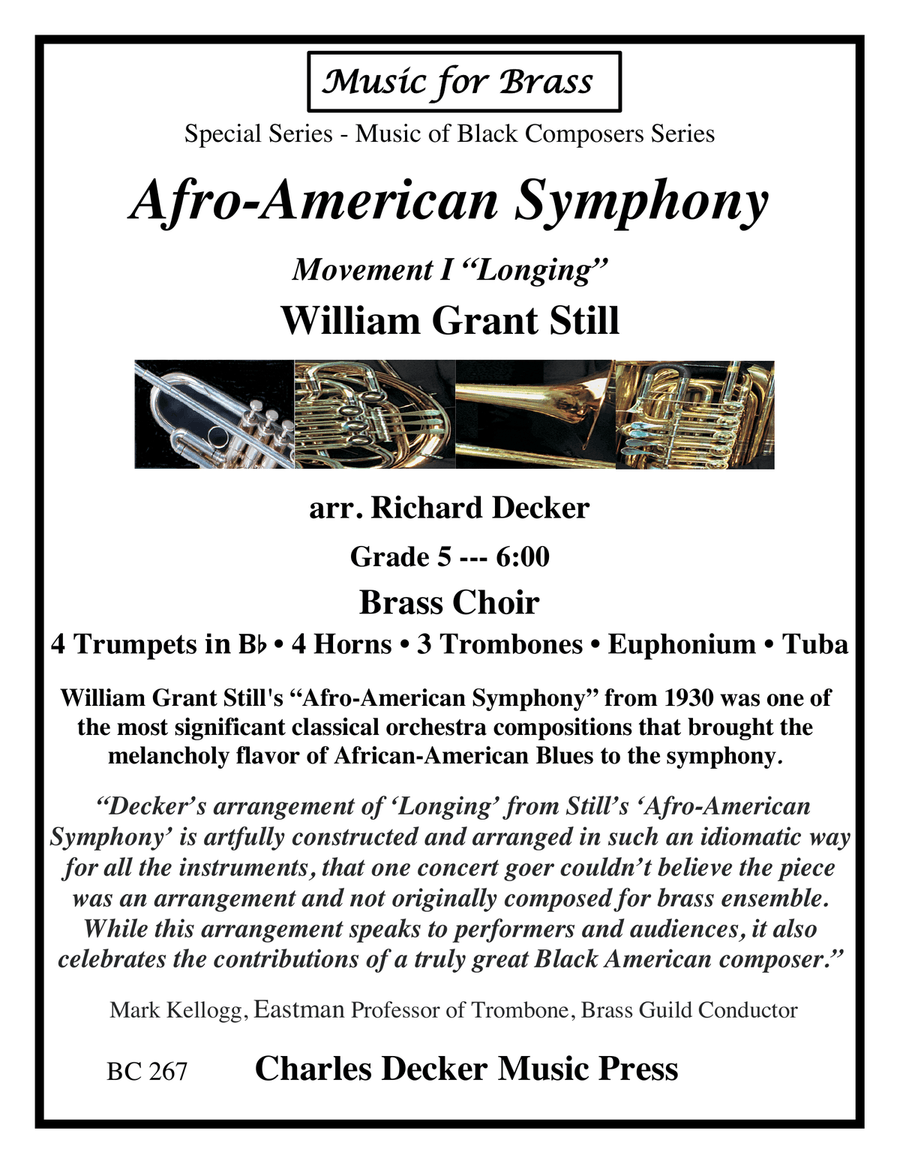Brass Band Euphonium,Horn,Trombone,Trumpet,Tuba - Level 5 - Digital Download SKU: A0.1095398 Composed by William Grant Still. Arranged by Richard Decker. 20th Century,Blues,Classical,Contest,Festival,Multicultural,World. 61 pages. Charles Decker Music Press #699415. Published by Charles Decker Music Press (A0.1095398). This is a brilliant arrangement of the first movement Longing of William Grant Still's Afro-American Symphony for a brass choir of four B-flat trumpets, four horns in F, three trombones, euphonium and tuba. William Grant Still's Afro-American Symphony was one of the most significant classical orchestra compositions of the early 1930s to incorporate African-American folk influences. Premiered by the Rochester Philharmonic Orchestra in October 1931 at conductor Howard Hanson's notable American Music Festival, it brought the melancholy flavor of the Blues to the symphony. For William Grant Still the Blues was a distinct African-American musical contribution, separate from the spiritual and popular jazz, and he wanted to incorporate it into a symphonic work based on Western classical symphonic instrumentation and forms. As part of the early 20th Century Harlem Renaissance in New York City, this work was enthusiastically received across the USA and overseas. Pair this brass choir arrangement of the first movement Longing with the third movement Humor also at Charles Decker Music Press to enliven a concert with colorful rhythms, soulful melodies and blues harmonies. Beyond brass ensemble programs feature your band or orchestra brass section on this memorable and exciting arrangement. âThe Music of Black Composers Series is a welcome and timely addition to the brass repertoire. Interesting music, expertly arranged, fun to perform, and well received by audiences. Highly recommended!â  Wesley Nance, Rochester Philharmonic Orchestra, Eastman School of MusicâI was so pleased to see the great works arranged for brass ensemble by Charles Decker Music Press especially the Music of Black Composersâ Series. It was especially rewarding to perform several of these with Summit Brass and with the students attending the Rafael Mendez Brass institute. Please keep these wonderful settings coming. You have provided the brass world with some real gems.â  Joseph Parisi, Director Summit Brass, Fountain City Brass Band, University of Missouri Kansas City Conservatory Wind EnsembleThe Interlochen Arts Academy and the University of Denver have purchased the Music of Black Composer Series with Charles Decker Music Press and the summer Rafael Mendez Brass Institute and Eastman School of Music uses the series arrangements in their chamber and brass ensembles music programs. See 50+ homogeneous brass editions for trumpet, horn and trombone ensembles and 75+ mixed brass ensemble publications with Charles Decker Music Press at Sheet Music Plus for inexperienced to advanced musicians with music ranging from the Renaissance to contemporary new works for trios, quartets, quintets, brass choir and brass band. Many of the mixed brass ensemble editions include alternate and substitute parts being alternate C trumpet parts for B-flat trumpet parts, flugelhorn/trumpet substitute for horn, horn substitute for trombone and treble clef euphonium substitute for trombone. To see our Music of Black Composers Series enter âBlack Composers Seriesâ in the search box at Charles Decker Music Press for 25 arrangements for mixed brass ensembles ranging from early jazz to symphonic works with composers Samuel Coleridge-Taylor, R. Nathaniel Dett, William Grant Still, Will Marion Cook, James Reese Europe, James Johnson and others.
